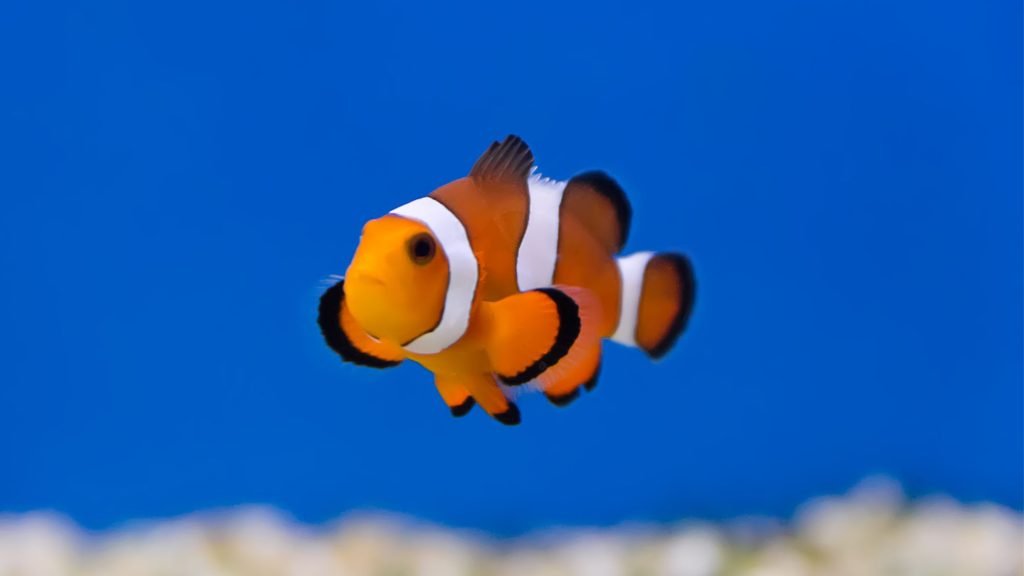Clown Fish as Pets: Your all-in-one resource for creating a vibrant marine environment. Learn from experts, apply proven care tips, and experience the joy of a thriving aquarium.
Do you find yourself captivated by clownfish’s vibrant colors and unique personalities?
If so, you’re not alone. Many people are intrigued by keeping these fascinating creatures as pets, but there’s much to learn before diving in. In this comprehensive guide, we’ll cover everything you need to know about keeping clownfish as pets, from the different types of clownfish to their feeding habits, lifespans, and more.
Types of Clownfish
Ocellaris Clownfish
Often referred to as the “false percula” or “common clownfish,” the ocellaris clownfish is the most popular species for home aquariums. They are relatively small, with a maximum length of around 4 inches. Their orange bodies, with striking white bands and black edges, make them a visually appealing addition to any tank.
Percula Clownfish
The percula clownfish, or “true percula,” is very similar in appearance to the ocellaris clownfish but has thicker black bands separating its white stripes. Percula clownfish are slightly smaller than ocellaris, growing up to 3 inches long.
Maroon Clownfish
Maroon clownfish are more extensive than their ocellaris and percula counterparts, reaching up to 6 inches. They are known for their bold maroon color and three wide white bands. Maroon clownfish have a reputation for being more territorial and aggressive than other clownfish species, so they may not be the best choice for beginners.
Skunk Clownfish
Skunk clownfish have a white dorsal stripe from head to tail.
They are available in various colors, including orange, red, and black, and usually grow up to 4 inches long.
Setting up a Clownfish Tank
Tank Size and Environment
Clownfish do well in smaller aquariums, with a minimum of 20 gallons per pair. They are reef-dwelling fish, so providing them with an environment replicating their natural habitat is essential. Live rock formations and plenty of hiding spots are critical for their comfort and security.
Water Parameters
Clownfish thrive in a stable environment with consistent water parameters. A temperature range of 74-79°F, a pH of 8.1-8.4, and a specific gravity of 1.020-1.025 is ideal. To maintain these parameters, invest in a reliable heater, and perform regular water testing and changes.
Tankmates
Clownfish are generally peaceful and can coexist with other non-aggressive fish species. However, they can be territorial towards other clownfish, so limiting your tank to one pair is best. Suitable tankmates include cardinalfish, gobies, and peaceful invertebrates like shrimp and snails.
Feeding Your Clownfish
Clownfish are omnivores and require a varied diet to stay healthy. High-quality marine flakes, pellets, and frozen and live foods like brine and mysis shrimp are excellent choices. Feed your clownfish 2-3 times daily, providing what they can consume within a few minutes.
Where to Buy a Clownfish
When buying a clownfish, it’s crucial to find a reputable breeder or retailer to ensure the health and well-being of your new pet. Many clownfish are now captive-bred, which is a more sustainable and ethical option than wild-caught specimens. Research local fish stores or online vendors and look for reviews from previous customers to ensure you’re making an informed decision.
Clownfish Lifespan and Health
How Long Do Clownfish Live?
Clownfish can have a relatively long lifespan for small marine fish when correctly cared for. Clownfish can live anywhere from 5 to 10 years or even longer in a well-maintained aquarium. Providing a stable environment, proper nutrition, and consistent maintenance will significantly increase the chances of your clownfish living a long and healthy life.
Common Clownfish Health Issues
Like any other fish, clownfish can be susceptible to various health issues. Some common health problems in clownfish include:
- Marine Ich (Cryptocaryon irritans): A parasite illness that causes lethargy and difficulty breathing in fish. Treatment includes copper-based medications or hypersalinity therapy.
- Brooklynella: A parasitic infection that affects the skin and gills, causing rapid breathing, excessive mucus production, and a “velvety” appearance. Treatment involves using a formalin-based medication.
- Bacterial infections: These can manifest as red sores, ulcers, or fin rot. Antibacterial medications, such as those containing kanamycin or erythromycin, are typically used for treatment.
- Nutritional deficiencies: A poor diet can lead to various health issues, including a weakened immune system and color fading. Provide a varied diet to prevent nutritional deficiencies.
Regularly monitoring your clownfish for signs of illness and maintaining proper water conditions will minimize the risk of health issues.
Clownfish Breeding
Determining the Sex of Clownfish
Clownfish are protandrous hermaphrodites, meaning they start life as males and can change into females if needed. In a pair of clownfish, the larger and more dominant individual will become the female, while the smaller one remains male. Once a clownfish has transitioned to female, it cannot change back to male.
Breeding Behavior and Process
Clownfish breeding in a home aquarium is possible with the right conditions. After pairing up, they may deposit eggs on a flat surface near their anemone or another hiding location.
The male fertilizes and guards the eggs while the female stays nearby.
The eggs typically hatch in 6-10 days, depending on the water temperature. Once the fry emerges, they must be fed live food, such as rotifers or baby brine shrimp, multiple times daily. As they grow, you can gradually introduce more significant foods and eventually transition them to a diet similar to that of adult clownfish.
Clownfish and Anemones: The Iconic Partnership
The Symbiotic Relationship
One of the most well-known aspects of clownfish is their unique relationship with sea anemones. Clownfish and anemones share a symbiotic relationship, with both parties benefiting from the partnership. The clownfish receive protection from predators, as the anemone’s stinging cells deter potential threats. In return, the clownfish defend the anemone from polyp-eating fish and provide it with food through their waste.
Suitable Anemones for Clownfish
Choosing a compatible species is crucial if you are considering adding an anemone to your clownfish tank. Some popular anemones that can host clownfish include:
- Bubble Tip Anemone (Entacmaea quadricolor)
- Carpet Anemone (Stichodactyla haddoni)
- Long Tentacle Anemone (Macrodactyla doreensis)
Remember that anemones have specific care requirements and can be more challenging to maintain than clownfish. Be sure to research the needs of the anemone species you’re interested in before adding it to your tank.
Clownfish Compatibility with Anemones
It’s important to note that not all clownfish will immediately form a bond with an anemone in a home aquarium. Captive-bred clownfish may not have the instinct to seek an anemone host. However, some clownfish may eventually partner with an anemone over time.
The Ethical Considerations of Keeping Clownfish
The Impact of the Aquarium Trade on Wild Clownfish Populations
The popularity of clownfish as pets has raised concerns about the aquarium trade’s impact on wild populations. Overharvesting and habitat destruction can pressure clownfish populations, potentially leading to a decline in their numbers. As a responsible pet owner, it’s essential to consider these ethical implications when choosing to keep clownfish as pets.
Supporting Sustainable Clownfish Breeding
One way to minimize your impact on wild clownfish populations is by choosing captive-bred specimens. Captive-bred clownfish are more sustainable and less likely to carry diseases or parasites than wild-caught fish. Additionally, they are typically better adapted to aquarium life, making them more suitable for beginners.
In conclusion, keeping clownfish as pets can be a rewarding experience for aquarists of all skill levels. With their vibrant colors, unique personalities, and fascinating behaviors, clownfish make beautiful additions to any home aquarium. By understanding the different types of clownfish, setting up a suitable tank, providing proper nutrition, and being mindful of ethical concerns, you’ll be well on your way to enjoying a successful and satisfying clownfish-keeping journey.

